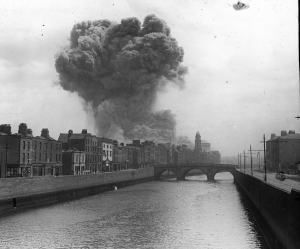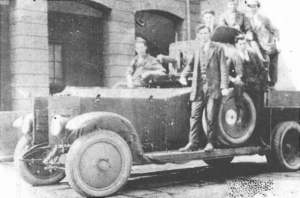Castledermot 1264— the first Irish parliament
Published in Features, Issue 3 (May/June 2014), Volume 22
The Four Courts on the afternoon of 30 June 1922, when the Record Treasury at the Public Record Office exploded, sending up a mushroom cloud—and countless priceless official documents. One of the anti-Treaty IRA garrison was the author’s great-uncle, Ned Horan (below), seen here in the turret of the commandeered armoured car, The Mutineer. Tom Barry has his leg astride the spare wheel. (South Dublin Libraries)
The historic meeting took place in Tristledermod, modern-day Castledermot, Co. Kildare. As a grand-nephew of a member of the anti-Treaty IRA Four Courts garrison of 1922, rediscovering an original manuscript of a contemporaneous record that is the earliest known documentary evidence of an assembly of state officials to call itself a parliament in Ireland seems like an interesting act of family atonement that links two important historical events. Even more curious are the Castledermot connections in a story separated by over 700 years of Ireland’s turbulent history!
My late grand-uncle, Edward (Ned) Horan, was born in Belan, Moone, Co. Kildare, but lived most of his adult life and reared his family in Castledermot, where he worked as a local mail contractor until his death. He was a member of the Four Courts garrison, which commandeered a Rolls-Royce armoured car known as The Mutineer that saw action during the Battle of Dublin in June 1922—the only armoured vehicle to see active service on the anti-Treaty side during the conflict. (It was subsequently captured by Free State forces and renamed The Ex-Mutineer.) It was during the afternoon of 30 June 1922 that the Record Treasury of the Public Record Office at the Four Courts was blown up, scattering Irish government records dating back to the twelfth century into a mushroom cloud over Dublin and apparently consigning them to oblivion.
Tracing the original manuscript record
Despite this tragic débâcle, an original manuscript record of the first documented gathering of the senior governing officials in thirteenth-century Anglo-Norman Ireland to call itself a parliament still exists. For this we owe a debt of gratitude to the chronicling abilities of two archbishops of Dublin and Glendalough. The first, Fulk Bassett de Sandeford, archbishop of Dublin 1256–71, was the subject of an inquisition at the parliament in question, which was held on the first Wednesday after the Feast of the Holy Trinity. (Interestingly, the 750th anniversary of the assembly occurs on the same date, day and religious calendar date!) Clearly the archbishop didn’t trust his contemporaries and had his own chronicler record the event. The record then found its way into the Liber Niger or the Black Book of Christchurch, which is the register of the key diocesan archives of Dublin and Glendalough from the twelfth to the fourteenth century. This manuscript is normally on display to the public in the crypt of Christ Church Cathedral, Dublin. Archbishop de Sandeford is buried in nearby St Patrick’s Cathedral. The Liber Niger was subsequently collated into the Alani Registrum (Bishop Alen’s Register) in the reign of Henry VIII by John Alen, archbishop of Dublin 1528–34 and lord chancellor 1529–32. This manuscript gives us an almanac of activities in the dioceses of Dublin, Glendalough and Kildare from c. 1172 to 1534, including a clear record of the parliament sitting in Castledermot in 1264.
The first recorded parliamentary sitting
 We know from the record exactly who was in attendance. The composition was typical of parliaments that had been sitting in England at the time. The key officials and magnates of state and 26 key landowning knights were present; all are named in the manuscript, although there is some indication that unnamed others may also have been in attendance. It is unclear whether Archbishop Fulk de Sandeford was actually present, despite the fact that his behaviour was the recorded matter on the agenda.
We know from the record exactly who was in attendance. The composition was typical of parliaments that had been sitting in England at the time. The key officials and magnates of state and 26 key landowning knights were present; all are named in the manuscript, although there is some indication that unnamed others may also have been in attendance. It is unclear whether Archbishop Fulk de Sandeford was actually present, despite the fact that his behaviour was the recorded matter on the agenda.
The sitting itself was more like a committee hearing or modern-day tribunal than a modern parliamentary sitting. The inquisition sought to adjudicate on the matter of the regalian rights of Archbishop Fulk de Sandeford and those of the then lord of Ireland, Prince Edward, son of Henry III. At the time the parliament took place, Henry III and his son, the future Edward I, were actually prisoners of Baron Simon de Montfort, who had defeated them at the Battle of Lewes on 14 May 1264. This was during the Second Barons’ War, a turbulent period in Henry’s reign that saw the emergence of parliaments instead of ‘great councils’. While the parliament in Ireland was not formally created until 1297 by Sir John Wogan, the sitting in Castledermot is acknowledged as the first gathering to call itself a parliament in Ireland, preceding the first parliament of elected members in England summoned by de Montfort in December 1264.
The inquisition at the parliament in Castledermot in 1264 was concerned with deciding whether the church (in the form of the archbishop) or the state (in the form of the English king’s representative as lord of Ireland) could hold courts and exercise justice. Castledermot was to see many more sittings of the itinerant parliament and great councils of state up until 1499. The location of the original parliament is unknown, but a later parliament house is reputed to have stood on the site of the Leinster Arms public house in the town square.
Paul F. Horan is an Assistant Professor of Nursing in Trinity College Dublin.
Read More: Who attended?
Further reading
Chancery Rolls (CIRCLE website, Trinity College Dublin), www.chancery.tcd.ie.
C. McNeill (ed.), Calendar of Archbishop Alen’s Register, c. 1172–1534 (Royal Society of Antiquaries of Ireland, Dublin, 1950).
H.G. Richardson & G.O. Sayles, The Irish parliament in the Middle Ages (Philadelphia, 1952).
















